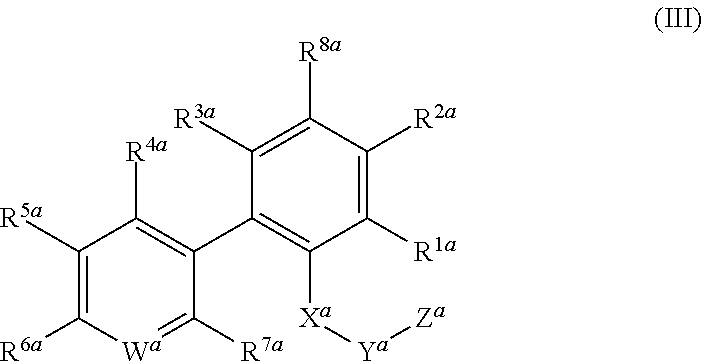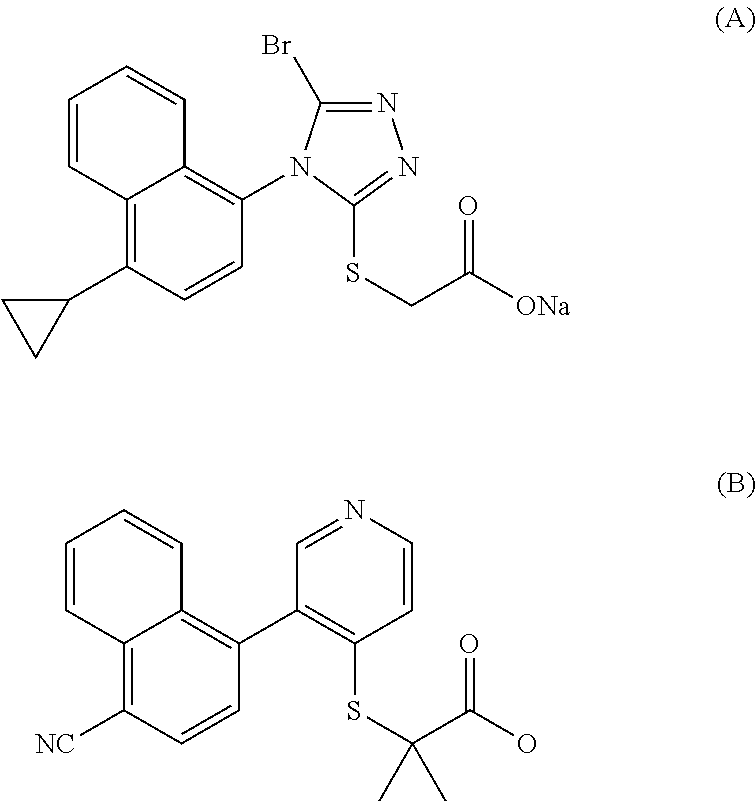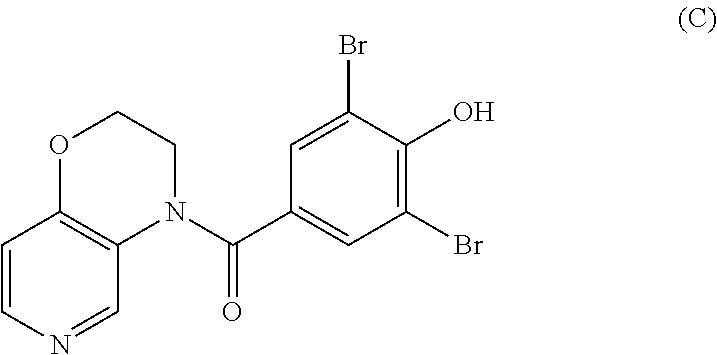Urat1 inhibitor
a technology of uratin and inhibitor, applied in the field of uratin inhibitor, can solve the problems of severe side effects of benzbromarone, and achieve the effects of excellent uric acid excretion promoting action, low cost, and high safety
- Summary
- Abstract
- Description
- Claims
- Application Information
AI Technical Summary
Benefits of technology
Problems solved by technology
Method used
Image
Examples
example 1
Ethyl 2-[[4′-cyano-(1,1′-binaphthalene)-2-yl]oxy]-2-methyl propanoate
[0449]
(1) 2′-Methoxy-(1,1′-binaphthalene)-4-carbonitrile 4-bromo-1-naphthonitrile
[0450](200 mg, 0.86 mmol), (2-methoxynaphthalen-1-yl)boronic acid (260 mg, 1.29 mmol), 5 [1,1′-bis(diphenylphosphino)ferrocene]palladium (II) dichloride dichloromethane adduct (70 mg, 0.09 mmol), potassium t-butoxide (145 mg, 1.92 mmol), and cesium fluoride (196 mg, 1.29 mmol) were dissolved in dioxane (9 mL), and the solution was stirred at 80° C. in a nitrogen atmosphere. After 16 hours, the reaction solution was allowed to be cooled to room temperature, diluted with ethyl acetate, and washed with water and brine. The organic layer was dried over sodium sulfate and filtered, and then the solvent was distilled off under reduced pressure. The obtained residue was purified by silica gel column chromatography (ethyl acetate:hexane=1:2) to obtain a title compound (200 mg, yield of 76%).
[0451]1H NMR (CDCl3, 400 MHz): δ=3.77 (s, 3H), 7.03 (...
example 2
2-[(4′-Cyano-(1,1′-binaphthalene)-2-yl]oxy]-2-methylpropanoic acid
[0456]
[0457]Ethyl 2-[(4′-cyano-[1,1′-binaphthalene]-2-yl)oxy]-2-methyl propanoate (108 mg, 0.26 mmol) obtained in Example 1 was dissolved in methanol (1 mL) and tetrahydrofuran (1 mL), 2 M sodium hydroxide aqueous solution (0.5 mL) was added thereto, and the solution was stirred at room temperature. After 1 hour, 1 M hydrochloric acid (1 mL) was added to the reaction solution to adjust to pH 7 and then the solvent was distilled off under reduced pressure. The obtained residue was purified by silica gel column chromatography (methanol:chloroform=1:10) to obtain a title compound (light yellow crystal, 65 mg, yield of 63%).
[0458]1H NMR (CDCl3, 400 MHz): δ=1.24 (s, 6H), 7.08 (d, 1H, J=8 Hz), 7.2-7.5 (m, 5H), 7.51 (d, 1H, J=7 Hz), 7.68 (t, 1H, J=6 Hz), 7.87 (t, 2H, J=6 Hz), 8.03 (d, 1H, J=7 Hz), 8.34 (d, 1H, J=8 Hz).
example 3
Ethyl 2-[(4′-cyano[1,1′-binaphthalene]-2-yl)thio]-2-methyl propanoate
[0459]
(1) Dimethylcarbamothioic acid O-(4′-cyano[1,1′-binaphthalene]-2-yl)
[0460]2′-Hydroxy-[1,1′-binaphthalene]-4-carbonitrile (158 mg, 0.53 mmol) obtained in Example 1 (2) and 1,4-diazabicyclo[2.2.2]octane (119 mg, 1.06 mmol) were dissolved in dimethylformamide (5 mL), dimethylthiocarbamoyl chloride (98 mg, 0.80 mmol) was added thereto, and the solution was stirred at 80° C. in a nitrogen atmosphere. After 16 hours, the reaction solution was allowed to be cooled to room temperature, diluted with ethyl acetate, and washed with water and brine. The organic layer was dried over sodium sulfate and filtered, and then the solvent was distilled off under reduced pressure. The obtained residue was purified by silica gel column chromatography (ethyl acetate:hexane=1:2) to obtain a title compound (63 mg, yield of 31%).
[0461]1H NMR (CDCl3, 400 MHz): δ=2.55 (s, 3H), 3.17 (s, 3H), 7.17 (d, 1H, J=8 Hz), 7.3-7.4 (m, 1H), 7.4-7.6...
PUM
| Property | Measurement | Unit |
|---|---|---|
| temperature | aaaaa | aaaaa |
| temperature | aaaaa | aaaaa |
| temperature | aaaaa | aaaaa |
Abstract
Description
Claims
Application Information
 Login to View More
Login to View More - R&D
- Intellectual Property
- Life Sciences
- Materials
- Tech Scout
- Unparalleled Data Quality
- Higher Quality Content
- 60% Fewer Hallucinations
Browse by: Latest US Patents, China's latest patents, Technical Efficacy Thesaurus, Application Domain, Technology Topic, Popular Technical Reports.
© 2025 PatSnap. All rights reserved.Legal|Privacy policy|Modern Slavery Act Transparency Statement|Sitemap|About US| Contact US: help@patsnap.com



